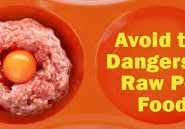
In a two-year study spanning from October 2010 through July 2012, the FDA Center for Veterinary Medicine (CVM) screened over 1,000 samples of pet food for bacteria that can cause foodborne illnesses. (The illnesses are called “foodborne” because the bacteria are carried, or “borne,” in or on contaminated food.) The study showed that, compared to other types of pet food tested, raw pet food was more likely to be contaminated with disease-causing bacteria.
Raw pet food was not included in the first year of the study. In the second year, CVM expanded the study to include 196 samples of commercially available raw dog and cat food. The center bought a variety of raw pet food online from different manufacturers and had the products shipped directly to six participating laboratories. The raw pet food products were usually frozen in tube-like packages and made from ground meat or sausage.
The participating laboratories analyzed the raw pet food for harmful bacteria, including Salmonella and Listeria monocytogenes. In past projects, CVM had monitored dog and cat food for the presence of Salmonella. But before this study, the center “had not investigated the occurrence of Listeria in pet food,” said Renate Reimschuessel, a veterinarian at CVM’s Office of Research and one of the study’s principal investigators. Dr. Reimschuessel further noted that “quite a large percentage of the raw foods for pets we tested were positive for the pathogen Listeria monocytogenes.” (Pathogens are disease-causing germs, like some bacteria. Not all bacteria are harmful pathogens, though. Some bacteria are helpful to people and animals, such as those that live in the intestines and contribute to a healthy gut.)
Of the 196 raw pet food samples analyzed, 15 were positive for Salmonella and 32 were positive for L. monocytogenes (see Table 1).
| Type of Pet Food Sample | No. samples tested | No. positive for Salmonella | No. positive for L. monocytogenes |
|---|---|---|---|
| Raw pet food | 196 | 15 | 32 |
| Dry exotic pet food | 190 | 0 | 0 |
| Jerky-type treats | 190 | 0 | 0 |
| Semi-moist dog food | 120 | 0 | 0 |
| Semi-moist cat food | 120 | 0 | 0 |
| Dry dog food | 120 | 0 | 0 |
| Dry cat food | 120 | 1 | 0 |
| Non cat and non dog food, such as dry pellets for hamsters, gerbils, rabbits, amphibians, and birds. Included chicken jerky product, pig ears, and bully stick-type products. Typically packaged in pouches for retail sale, such as pouched dog and cat food; and food treats shaped like bacon, fish, pork chops, and burgers. Included pellet or kibble type food typically packaged in bags for retail sale.Note: CVM did not collect or test canned and wet pet food samples in this study. |
|||
Based on the study’s results, CVM is concerned about the public health risk of raw pet food diets. As Dr. Reimschuessel explained, the study “identified a potential health risk for the pets eating the raw food, and for the owners handling the product.” Owners who feed their pet a raw diet may have a higher risk of getting infected with Salmonella and Listeria monocytogenes.
Tips to Prevent Foodborne Illness from Raw Pet Food
Because raw pet food is more likely than other types of pet food to contain Salmonella and Listeria monocytogenes, the single best thing you can do to prevent infection is to not feed your pet a raw diet. However, the FDA Center for Veterinary Medicine is aware that some people prefer to feed their pets this type of diet.
If you choose to feed raw pet food to your pet, be aware that you can infect yourself with Salmonella or L. monocytogenes by spreading the bacteria from the contaminated food to your mouth. For instance, you may accidentally ingest the bacteria if you touch your mouth while preparing the raw food or after handling a contaminated utensil. If you get Salmonella or L. monocytogenes on your hands or clothing, you can also spread the bacteria to other people, objects, and surfaces.
Here are some tips to prevent infection with Salmonella and L. monocytogenes:
The Difference between Cleaning and Disinfecting
Cleaning removes germs (like bacteria) and dirt from surfaces and objects. Cleaning works by using soap (or detergent) and water to physically remove germs and dirt. This process doesn’t necessarily kill germs, but by removing them, cleaning lowers the number of germs and the risk of spreading infection.
Disinfecting kills germs on surfaces and objects. Disinfecting works by using chemicals, such as bleach, to kill germs. This process doesn’t necessarily clean dirty surfaces and objects or remove germs, but by killing germs after cleaning, disinfecting can further lower the risk of spreading infection.
No matter what type of pet food you feed your pet, you should always follow safe food preperation and hygiene procedures.